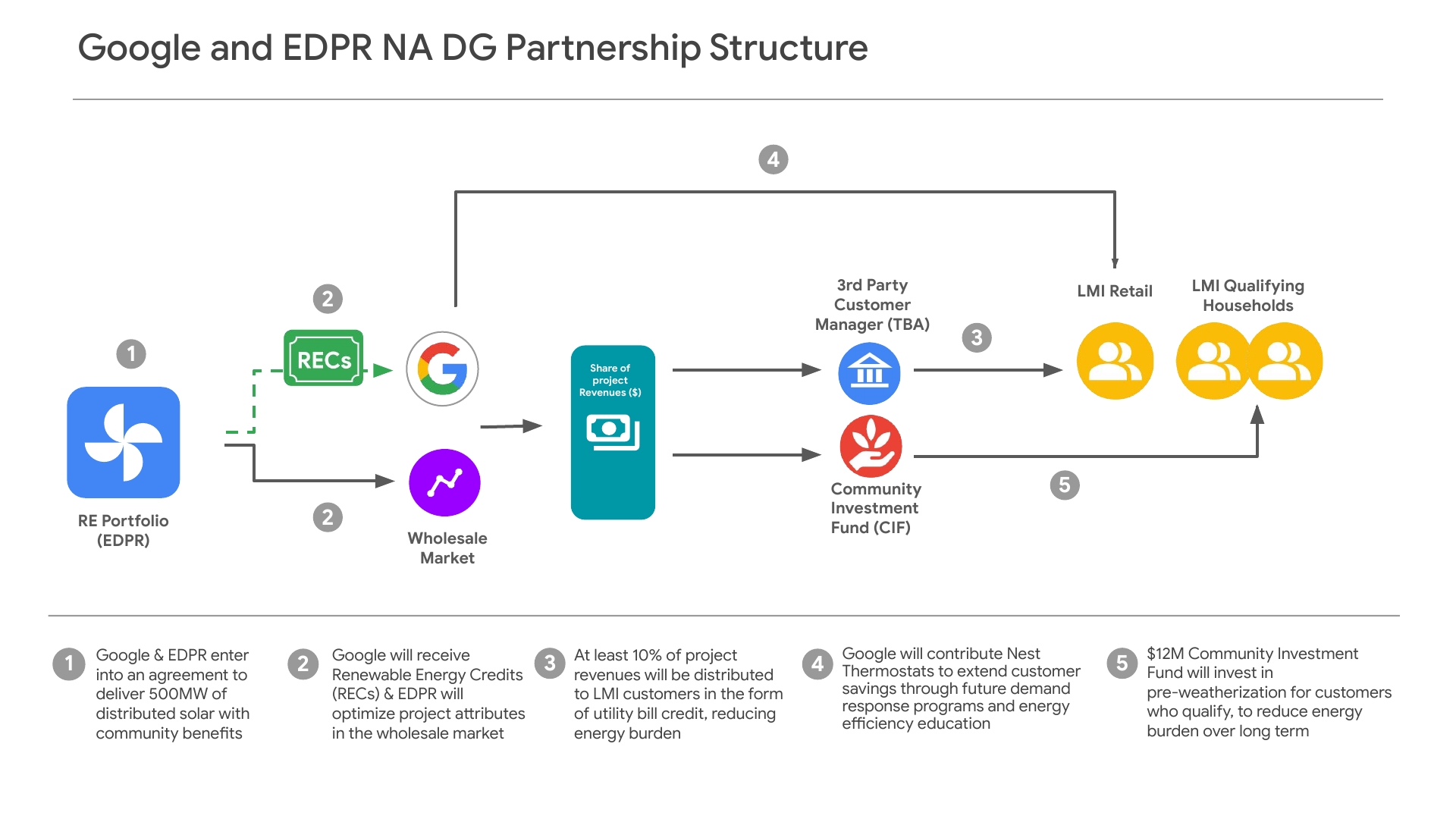
EDP Renewables and Google plan to develop and install more than 80 distributed solar projects together. (Source: Shutterstock)
Tech giant Google and EDP Renewables (EDPR) are working together to develop 650 megawatts (MW) of distributed energy across the U.S. in an effort to put cleaner energy within reach of low- to moderate-income families. The companies said their efforts are the largest U.S. corporate sponsorship of distributed solar PV.
Working through its North American distributed generation arm, EDPR said April 24 it signed a framework with Google to develop and install more than 80 distributed solar projects, with initial focus in the PJM Interconnection service area.
Starting in Ohio, home to a Google data center campus and Google Cloud region, the projects will expand into a total of six states. The first projects are expected to be operational by year-end 2024.
The project has been in the making for more than two years as the companies sought to “democratize access to cleaner energy” while lowering electricity bills to ensure an equitable energy transition.
“Achieving the required grid decarbonization to keep the world from warming more than 1.5 degrees Celsius will require more than just Google. We know that if we achieve our goals in a vacuum, we have failed,” Amanda Peterson Corio, Google’s global head of Data Center Energy, said on a media call. “As we work to decarbonize our electricity grids, we need to ensure that we’re not just doing so on our own. It’s not enough just to make our grids clean if we are not also ensuring that we’re doing so in a just and equitable manner.”
The solar energy partnership comes as the U.S. targets 80% renewable energy generation by 2030, with eyes set on becoming carbon-free by 2035. Like other parts of the world, the U.S. also has ambitions to achieve net-zero emissions by 2050. The government has rolled out paths for clean energy technologies and tax incentives to encourage development.

Equity is a part of the Biden administration’s clean energy push.
The portfolio of solar projects will be funded in part by Google’s acquisition of novel Impact Renewable Energy Certificates (RECs), defined by EDPR as an “instrument that certifies that a given buyer has the rights to the environmental and social benefits of the renewable electricity produced by a renewable project.”
The ImpactRECs have all the elements of traditional compliance renewable energy credits, but with added covenants geared toward localized investment and community benefits that “allow us to effectively and synthetically create the economic benefits of community solar,” without relying on existing or new tariff allocations that are sparse and are state-by-state, said Rich Dovere, chief investment officer for EDPR NA Distributed Generation.
In addition to lowering the energy burden of households by creating a community investment fund, 10% of the energy revenues will flow to LMI customers as a bill credit.
The U.S. Department of Energy (DOE) defines community solar as a solar project or purchasing program that allows multiple customers—including individuals, businesses and nonprofits—to reap the benefits of a solar project. Such customers typically lease or buy a portion of the solar panels in the array and get an electric bill credit for electricity generated by their share of the community solar system.
The DOE calls community solar “a great option for people who are unable to install solar panels on their roofs because they don’t own their homes, have insufficient solar resources or roof conditions to support a rooftop PV system due to shading, roof size, or other factors, or for financial/other reasons.”
While some states have programs that offer community solar access to low-income customers, EDPR pointed out in a blogpost that the current community solar structure is too reliant on state subsidies and legislative action.
No longer will developers have to wait for community solar tariffs to come out before starting on projects in regions with competitive wholesale markets, Dovere added.
“We’re able to leverage a premium REC product with Google and [with] hopefully other credit buyer participation in the future that allows for us to create the same type of benefits,” he said.
Those community benefits will include, for example, investments in fire stations, police stations and schools. “And most importantly, creating a direct economic benefit for repairs in the form of bill credits,” he added. “So, if you think about what a community solar project typically creates, it is a discount to the bill. We are going to be doing that synthetically in the form of this bill credit that is coming as a covenant as part of the ImpactREC product.”
The community impact fund to be created will be valued at $12 million and focus on efforts to reduce energy poverty in communities where the projects are built, according to EDPR.
Recommended Reading
Defeating the ‘Four Horsemen’ of Flow Assurance
2024-04-18 - Service companies combine processes and techniques to mitigate the impact of paraffin, asphaltenes, hydrates and scale on production—and keep the cash flowing.
TGS, SLB to Conduct Engagement Phase 5 in GoM
2024-02-05 - TGS and SLB’s seventh program within the joint venture involves the acquisition of 157 Outer Continental Shelf blocks.
2023-2025 Subsea Tieback Round-Up
2024-02-06 - Here's a look at subsea tieback projects across the globe. The first in a two-part series, this report highlights some of the subsea tiebacks scheduled to be online by 2025.
StimStixx, Hunting Titan Partner on Well Perforation, Acidizing
2024-02-07 - The strategic partnership between StimStixx Technologies and Hunting Titan will increase well treatments and reduce costs, the companies said.
Tech Trends: QYSEA’s Artificially Intelligent Underwater Additions
2024-02-13 - Using their AI underwater image filtering algorithm, the QYSEA AI Diver Tracking allows the FIFISH ROV to identify a diver's movements and conducts real-time automatic analysis.






